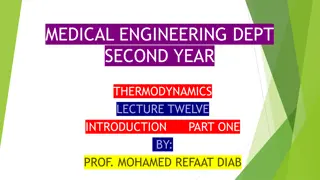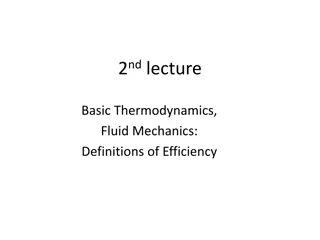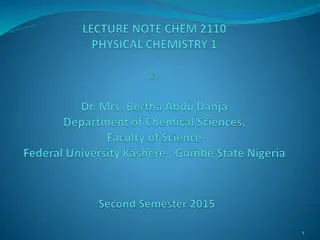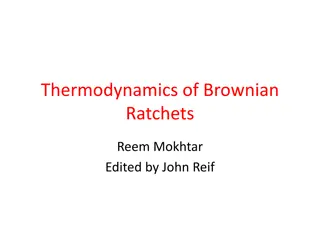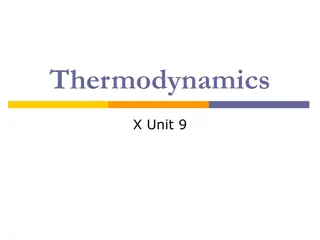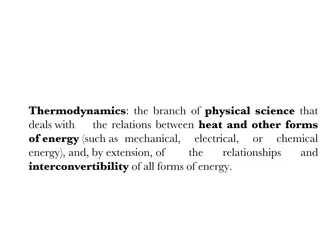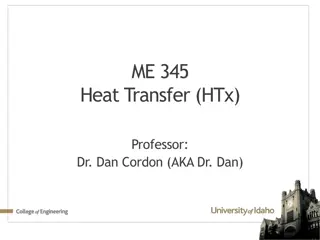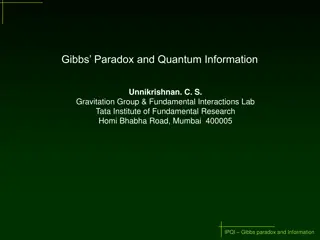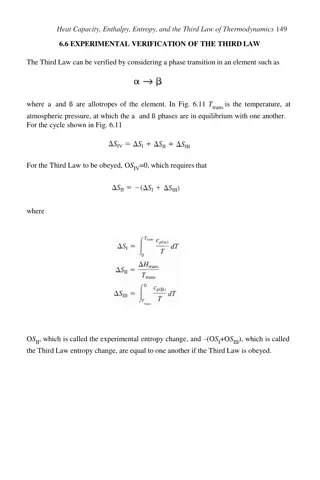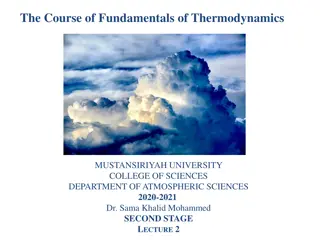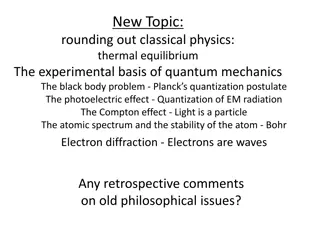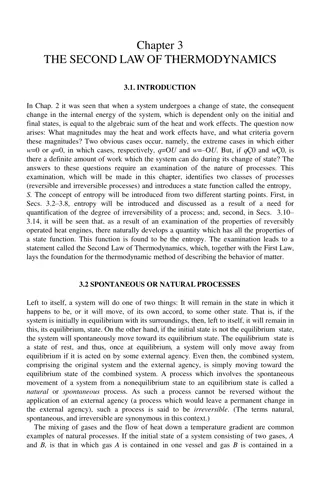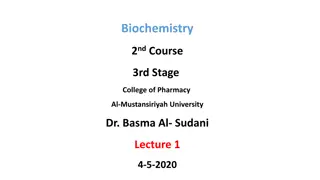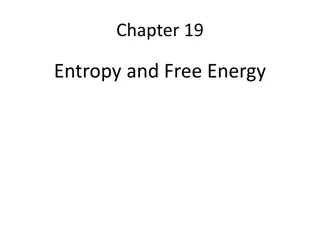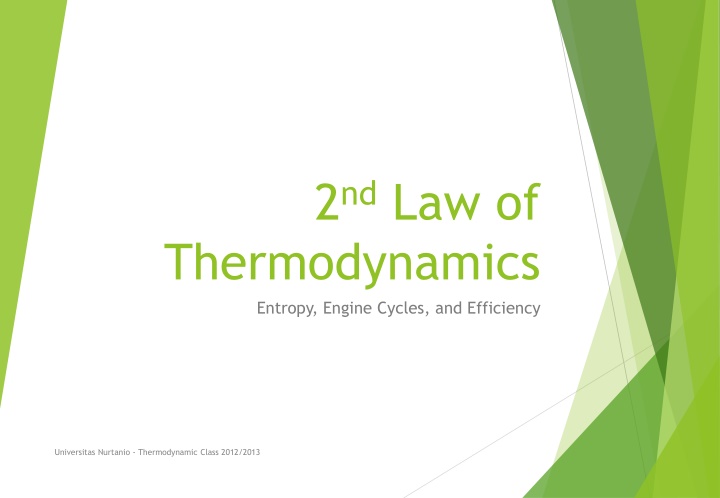
Thermodynamics Concepts and Perfect Gas Introduction at Universitas Nurtanio
Explore the fundamental concepts of thermodynamics, including entropy, engine cycles, and efficiency at Universitas Nurtanio. Learn about perfect gases and their properties, ideal gas state equation, internal energy, and enthalpy. Dive into examples and applications to deepen your understanding. Get insights into the 2nd Law of Thermodynamics and its implications on system behavior. Enhance your knowledge in thermodynamics with practical examples and theoretical foundations.
Download Presentation

Please find below an Image/Link to download the presentation.
The content on the website is provided AS IS for your information and personal use only. It may not be sold, licensed, or shared on other websites without obtaining consent from the author. If you encounter any issues during the download, it is possible that the publisher has removed the file from their server.
You are allowed to download the files provided on this website for personal or commercial use, subject to the condition that they are used lawfully. All files are the property of their respective owners.
The content on the website is provided AS IS for your information and personal use only. It may not be sold, licensed, or shared on other websites without obtaining consent from the author.
E N D
Presentation Transcript
2ndLaw of Thermodynamics Entropy, Engine Cycles, and Efficiency Universitas Nurtanio - Thermodynamic Class 2012/2013
BONUS TRACK. Introducing the Perfect Gas Remember that gas is a collection of particles which are moving in random motion. Due to structure of the molecules, there is a molecular forces between particles that interact with each other and creating a force field. However, if the distance between particles are vast enough, this forces interaction become small and can be neglected. A gas in which the inter-molecular forces are neglected, is called a perfect gas. This assumption is valid for wide range of temperature and pressure
BONUS TRACK. Please recall ideal gas state equation: Perfect gas: / n / M adalah specific gas constant in Universitas Nurtanio - Thermodynamic Class 2012/2013 Untuk udara,
BONUS TRACK. Internal energy and enthalpy Enthalpy didefinisikan sebagai: Yang turunan-nya menjadi, Atau dalam besaran spesifik, Dan untuk calorically perfect gas dimana cp dan cv adalah konstan, Untuk perfect gas, u & h adalah state variables dan tidak bergantung pada proses. Universitas Nurtanio - Thermodynamic Class 2012/2013
BONUS TRACK For a perfect gas, Divide above equation with cp, Divide above equation with cv, And since And since or or
BONUS TRACK. Example: Diketahui sebuah ruangan tertutup dengan panjang 7 m, lebar 5 m, dan tinggi 3 m. Pada suatu kondisi, temperatur dan tekanan udara dalam ruangan tersebut adalah 25 C dan 1 atm. Hitung energi dalam dan enthalpy dari udara dalam ruangan tersebut! 1 atm = 1.01*10e5 Pa Ans: U=2.92 x 10e7 Joule H=4.08 x 10e7 Joule 1 C = 273 K Universitas Nurtanio - Thermodynamic Class 2012/2013
INTRO TO 2ND LAW Consider this: Sistem: udara bertekanan tinggi dalam tabung. Ketika katup dibuka, maka udara akan keluar dan membuat tekanan dalam tabung sama dengan lingkungannya. (equilibrium) Berdasar insting, kita bisa berkata bahwa inilah proses yang terjadi secara spontan dan bukan sebaliknya. Universitas Nurtanio - Thermodynamic Class 2012/2013
INTRO TO 2ND LAW Consider this: Namun, hukum pertama sebetulnya tidak pernah membatasi inilah proses yang terjadi. Selama energi terkonservasi dalam proses tersebut. Hukum pertama membolehkan, ketika katup dibuka, udara dari lingkungan akan masuk ke dalam tabung dan termampatkan, selama energi kekal. Proses ini tidak mungkin terjadi secara spontan. Universitas Nurtanio - Thermodynamic Class 2012/2013
INTRO TO 2ND LAW Consider this: Dibutuhkan perangkat untuk memberitahu kita, apa proses yang terjadi secara spontan, dan kemana arahnya. Hukum ke-dua. Universitas Nurtanio - Thermodynamic Class 2012/2013
INTRO TO 2ND LAW Irreversibility of a process Irreversible process Jika suatu sistem mengalami proses, maka proses tersebut dikatakan irreversible jika tidak dapat dilakukan secara terbalik dan sistem tidak dapat dikembalikan ke keadaan semula-nya. Reversible process Proses reversibel adalah proses dimana sistem dan lingkungannya dapat dengan tepat dikembalikan ke keadaan awalnya setelah satu proses berlangsung. Universitas Nurtanio - Thermodynamic Class 2012/2013
INTRO TO 2ND LAW Irreversibility of a process All actual processes are irreversible! Entropy of the universe is always growing. And process tend to occur in a direction that gives positive change in entropy. We used reversible assumption to simplify an analysis, or to determine the best (maximum) thermodynamic performance of a systems. Universitas Nurtanio - Thermodynamic Class 2012/2013
INTRO TO 2ND LAW Cunning thought to power cycle Consider again our expanding gas example. Instead of permitting the air to expand aimlessly into the lower-pressure surroundings, the stream could be passed through a turbine and work could be developed. Recognizing this possibility for work, we can pose two questions: What is the theoretical maximum value for the work that could be obtained? What are the factors that would preclude the realization of the maximum The second law of thermodynamics provides the means for determining the theoretical maximum and evaluating quantitatively the factors that preclude attaining the maximum. value? Universitas Nurtanio - Thermodynamic Class 2012/2013
THE 2ND LAW STATEMENT Clausius and Kelvin-Planck Statement By Clausius: Adalah tidak mungkin suatu sistem beroperasi dalam siklus thermodinamik dan hanya secara spontan mentransfer energi dalam bentuk panas dari resoir bersuhu rendah ke resevoir bersuhu lebih tinggi Untuk dapat memindahkan energi dari temperatur rendah ke temperatur tinggi, dibutuhkan usaha yang ditambahkan ke dalam sistem. e.g.: mesin pendingin Universitas Nurtanio - Thermodynamic Class 2012/2013
THE 2ND LAW STATEMENT Clausius and Kelvin-Planck Statement By Kelvin-Planck: Adalah tidak mungkin suatu sistem dapat beroperasi dalam siklus thermodinamik dan hanya menghasilkan energi dalam bentuk kerja, jika menerima energi dalam bentuk kalor dari satu reservoir termal. Universitas Nurtanio - Thermodynamic Class 2012/2013
THE 2ND LAW STATEMENT Clausius and Kelvin-Planck Statement A constraint is imposed by the first law on the net work and heat transfer between the system and its surroundings. According to the cycle energy balance, In words, the net work done by the system undergoing a cycle equals the net heat transfer to the system. Although the cycle energy balance allows the net work Wcycle to be positive or negative. Universitas Nurtanio - Thermodynamic Class 2012/2013
THE 2ND LAW STATEMENT Clausius and Kelvin-Planck Statement According to the Kelvin Planck statement, a system undergoing a cycle while communicating thermally with a single reservoir cannot deliver a net amount of work to its surroundings. That is, the net work of the cycle cannot be positive. However, the Kelvin Planck statement does not rule out the possibility that there is a net work transfer of energy to the system during the cycle or that the net work is zero. Universitas Nurtanio - Thermodynamic Class 2012/2013
THE 2ND LAW IMPLICATION TO POWER CYCLES If the value of QC were zero, thermal efficiency of such a cycle would have a value of unity (100%). This method of operation would violate the Kelvin Planck statement and thus is not allowed. Only a portion of the heat transfer QH can be obtained as work, and the remainder, QC, must be discharged by heat transfer to the cold reservoir Universitas Nurtanio - Thermodynamic Class 2012/2013
THE 2ND LAW IMPLICATION TO POWER CYCLES The coefficient of performance for a power cycle is Universitas Nurtanio - Thermodynamic Class 2012/2013
THE 2ND LAW IMPLICATION TO REFRIGERATION & HEAT PUMP CYCLES As the net work input to the cycle Wcycle tends to zero, the coefficients of performance approach infinity. This method of operation would violate the Clausius statement and thus is not allowed. Coefficients of performance must invariably be finite in value. Universitas Nurtanio - Thermodynamic Class 2012/2013
THE 2ND LAW IMPLICATION TO REFRIGERATION & HEAT PUMP CYCLES The coefficient of performance For a refrigeration cycle is The coefficient of performance for a heat pump cycle is Universitas Nurtanio - Thermodynamic Class 2012/2013
THE 2ND LAW IMPLICATION EXAMPLE: By steadily circulating a refrigerant at low temperature through passages in the walls of the freezer compartment, a refrigerator maintains the freezer compartment at -5 C when the air surrounding the refrigerator is at 22 C. The rate of heat transfer from the freezer compartment to the refrigerant is 8000 kJ/h and the power input required to operate the refrigerator is 3200 kJ/h. Determine the coefficient of performance of the refrigerator and compare with the coefficient of performance of a reversible refrigeration cycle operating between Universitas Nurtanio - Thermodynamic Class 2012/2013 reservoirs at the same two temperature!
THE 2ND LAW IMPLICATION EXAMPLE: Known: Tc = -5 C =268 K 268 268 Th = 22 C = 295 K Q = = = . 9 93 295 268 27 = 8000 kJ/h c W = 3200 kJ/h cycle 8000 / kJ h Q = = 2222 / c Joule s 2222= 3600 / s h = . 2 50 888 3200 / kJ h = = 888 / W c Joule s 3600 / s h Universitas Nurtanio - Thermodynamic Class 2012/2013
ENTROPY There exists for every system in equilibrium a property called entropy, which is a thermodynamic property of a system Entropi (S) : adalah ukuran ke- tidakberatur-an suatu sistem dalam skala mikroskopis. Entropi merupakan variabel keadaan (state variable) yang dapat digunakan untuk membantu memastikan arah dari suatu proses. Universitas Nurtanio - Thermodynamic Class 2012/2013
ENTROPY Mathematically, change of entropy is defined as: Where s is the entropy of the system, qrev is incremental amount of heat being added to the system in reversible process, and T is absolute temperature of the system. The equation defines change of entropy in term of reversible addition of heat. for irreversible/actual process, change of entropy is: Universitas Nurtanio - Thermodynamic Class 2012/2013
ENTROPY dsirrev is entropy generated due to irreversible, dissipative process. This dissipative process always increase entropy of the system. In above statement, the equal sign applied when process is reversible, giving out our first equation. If we combine the last two equations, we would have Common unit for entropy is Joule per degree Kelvin or J/K And further assuming if the process is adiabatic where For irreversible process, ds > 0 For reversible process, ds = 0 Universitas Nurtanio - Thermodynamic Class 2012/2013
ENTROPY Implication of this statement is that nature, always looking for a process in which resulted in net increase of entropy, or that entropy change is positive. Universitas Nurtanio - Thermodynamic Class 2012/2013
CARNOT CYCLE Siklus Carnot merupakan contoh yang bagus tentang siklus daya reversibel yang beroperasi di antara dua reservoir termal. Karena beroperasi secara reversible, maka siklus ini mampu menghasilkan effisiensi maksimum Universitas Nurtanio - Thermodynamic Class 2012/2013
CARNOT CYCLE Siklus Carnot terdiri atas 4 proses, yaitu 2 proses adiabatik dan 2 proses isotermik secara bergantian. Ada empat komponen dalam mesin karnot, yaitu: a) boiler, b) turbine, c) condenser, and d) pump Universitas Nurtanio - Thermodynamic Class 2012/2013
CARNOT CYCLE As the water flows through the boiler, a change of phase from liquid to vapor at constant temperature TH occurs as a result of heat received (Qin) from the hot reservoir. Since temperature remains constant, pressure also remains constant during the phase change. Universitas Nurtanio - Thermodynamic Class 2012/2013
CARNOT CYCLE The steam exiting the boiler expands adiabatically through the turbine and work is developed (Wout). In this process the temperature decreases to the temperature of the cold reservoir, TC, and there is an accompanying decrease in pressure. Universitas Nurtanio - Thermodynamic Class 2012/2013
CARNOT CYCLE As the steam passes through the condenser, a heat transfer to the cold reservoir (Qout) occurs and the vapor condenses into fluid at constant temperature TC. Since temperature remains constant, pressure also remains constant as the water passes through the condenser. Universitas Nurtanio - Thermodynamic Class 2012/2013
CARNOT CYCLE The fluid then compressed adiabatically by a pump and work is done to the fluid (Win) during this process. The temperature is changing from TC to TH and there is also change in pressure. Universitas Nurtanio - Thermodynamic Class 2012/2013
CARNOT CYCLE If a Carnot power cycle is operated in the opposite direction, the magnitudes of all energy transfers remain the same but the energy transfers are oppositely directed. Such a cycle may be regarded as refrigeration or heat pump cycle Universitas Nurtanio - Thermodynamic Class 2012/2013
ENGINE CYCLES Otto ENGINE CYCLES Rankine Diesel Brayton Universitas Nurtanio - Thermodynamic Class 2012/2013
ENGINE CYCLES Outlined view of how steam power plant (PLTU, in Indonesian) operates. Rankine cycle Otto cycle Diesel cycle Brayton cycle Universitas Nurtanio - Thermodynamic Class 2012/2013
ENGINE CYCLES The magic of the plant were in particular section denoted with the later A . But what happened here? Rankine cycle Otto cycle Diesel cycle Brayton cycle Universitas Nurtanio - Thermodynamic Class 2012/2013
ENGINE CYCLES Vapor from the boiler (at state 1), having an elevated temperature and pressure, expands through the turbine to produce Rankine cycle work and then is discharged to the condenser (at state 2) with relatively low pressure. The energy balance for turbine section, assuming a) no heat Otto cycle Diesel cycle transfer to the surrounding, and b) system is stationary is reduced to give the rate at which work is developed per unit of mass of Brayton cycle steam passing through the turbine Universitas Nurtanio - Thermodynamic Class 2012/2013 Cycle with 2 path
ENGINE CYCLES In the condenser there is heat transfer from the vapor (at state 2) to cooling water flowing in a separate stream. The vapor condenses Rankine cycle (at state 3) while the temperature of the coolant increases. Otto cycle The energy balance for condenser section assuming steady state, Diesel cycle gives the rate at which energy is transferred by heat from the working fluid to the coolant per unit mass of working fluid passing Brayton cycle through the condenser. Universitas Nurtanio - Thermodynamic Class 2012/2013
ENGINE CYCLES The liquid condensate leaving the condenser (at state 3) is pumped from the condenser into the higher pressure boiler (at Rankine cycle state 4). By pumping mechanism, work is added to the working Otto cycle fluid. The energy balance for pump section, assuming a) no heat Diesel cycle transfer to the surrounding, and b) system is stationary is reduced to give the rate of power input per unit of mass fluid passing Brayton cycle through the pump. Universitas Nurtanio - Thermodynamic Class 2012/2013 Cycle with 2 path Cycle with 4 path
ENGINE CYCLES The working fluid completes a cycle as the liquid leaving the pump (at state 4), called the boiler feedwater, is heated to Rankine cycle saturation and evaporated in the boiler (at state 1). Otto cycle The energy balance for boiler section, gives the rate of heat Diesel cycle transfer from the energy source into the working fluid per unit mass passing through the boiler Brayton cycle Universitas Nurtanio - Thermodynamic Class 2012/2013
ENGINE CYCLES The thermal efficiency defined as how much the energy inputted to the working fluid passing through the boiler is converted to the net work output. Rankine cycle Otto cycle Diesel cycle Brayton cycle Universitas Nurtanio - Thermodynamic Class 2012/2013 Cycle with 2 path Cycle with 4 path
ENGINE CYCLES Siklus Otto (motor bakar), paling banyak digunakan dalam kehidupan manusia. Mobil dan sepeda motor berbahan bakar bensin (Petrol Fuel) adalah contoh penerapan dari sebuah siklus Otto. Rankine cycle Otto cycle Terdiri dari 2 proses isentropik dan 2 proses isokhorik : Diesel cycle 1-2 : Kompresi isentropik Brayton cycle 2-3 : Pembakaran isokhorik 3-4 : Ekspansi isentropik 4-1 : Langkah buang isokhorik Universitas Nurtanio - Thermodynamic Class 2012/2013 Cycle with 2 path Cycle with 4 path
ENGINE CYCLES compression defined as the volume at bottom dead center divided by the volume at top dead center. ratio r is Universitas Nurtanio - Thermodynamic Class 2012/2013
ENGINE CYCLES Proses 1 2 adalah kompresi isentropik udara, ketika piston bergerak dari bottom dead center menuju top dead center. Rankine cycle Otto cycle Diesel cycle Brayton cycle Universitas Nurtanio - Thermodynamic Class 2012/2013 Cycle with 2 path Cycle with 4 path
ENGINE CYCLES Process 2 3 is a constant-volume heat transfer to the air from an external source while the piston is at top dead center. (combustion) Rankine cycle Otto cycle Diesel cycle Brayton cycle Universitas Nurtanio - Thermodynamic Class 2012/2013 Cycle with 2 path Cycle with 4 path
ENGINE CYCLES Process 3 4 is an isentropic expansion (power stroke). Rankine cycle Otto cycle Diesel cycle Brayton cycle Universitas Nurtanio - Thermodynamic Class 2012/2013 Cycle with 2 path Cycle with 4 path
ENGINE CYCLES Process 4 1 is constant-volume heat rejection from the air while the piston is at bottom dead center. Rankine cycle Otto cycle Diesel cycle Brayton cycle Universitas Nurtanio - Thermodynamic Class 2012/2013 Cycle with 2 path Cycle with 4 path
ENGINE CYCLES Rankine cycle Otto cycle Diesel cycle Brayton cycle K=1.4 Universitas Nurtanio - Thermodynamic Class 2012/2013
ENGINE CYCLES Siklus diesel untuk mesin diesel terdiri dari 2 proses isentropik, 1 proses isobarik dan 1 proses isokhorik Rankine cycle Otto cycle 1-2 : Kompresi isentropik Diesel cycle 2-3 : Pembakaran isobarik 3-4 : Ekspansi isentropik Brayton cycle 4-1 : Pembuangan isokhorik Universitas Nurtanio - Thermodynamic Class 2012/2013
ENGINE CYCLES Process 1 - 2 is the same as in the Otto cycle: an isentropic compression. Rankine cycle Otto cycle Diesel cycle Brayton cycle Universitas Nurtanio - Thermodynamic Class 2012/2013

